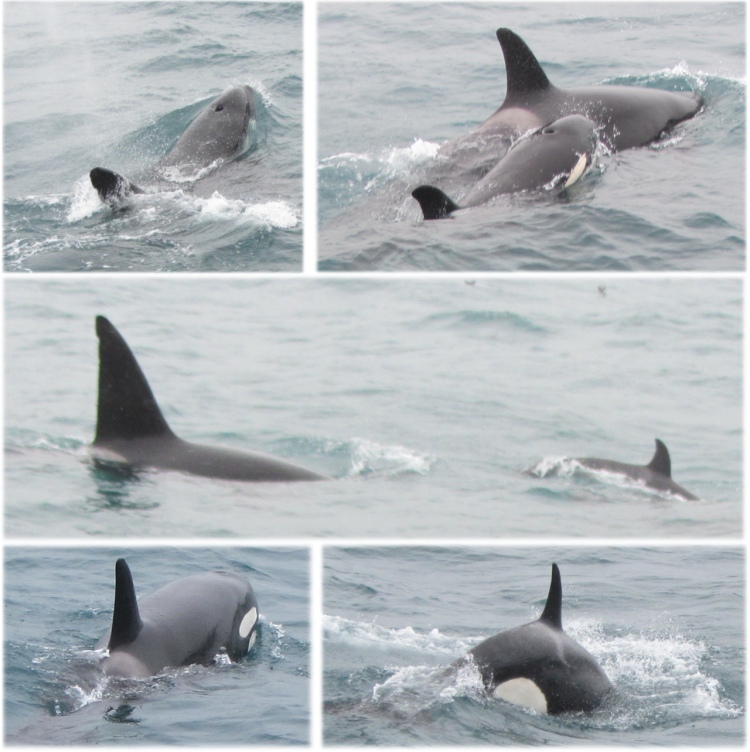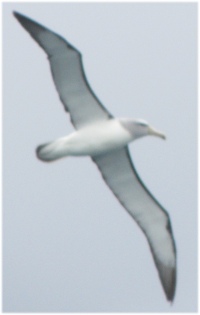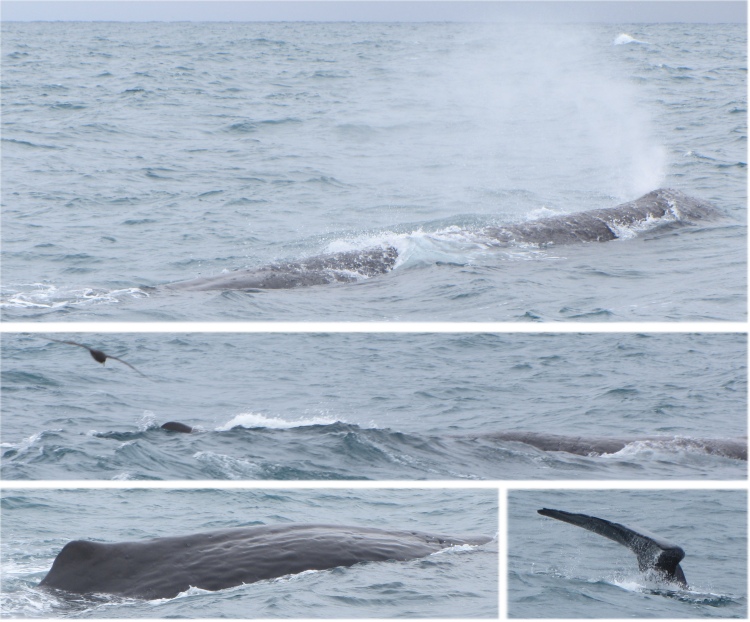 Orca Whales Hunting Close to the Marina |
After a relaxing warm shower, I managed to let the rain soak the bottom half of my mattress during my breakfast preparation. I noticed that something was starting to smell in the car, and I would dearly love to have a hot dry day to empty the wagon for a good airing and investigate what the smell could be.
I made my way down to the whale watch centre on the waterfront to see what the prognosis was for today. Winds were forecast to reach up to 25 knots. Warnings had been issued for the 09:30 tour that sea sickness may be a problem. My 10:00 tour had the additional warning that the weather was deteriorating, and there was a possibility of cancellation. Well, nothing like a bouncy sea to spice the trip up a bit.
 Orca Whales at Kaikoura Trench |
When we arrived, the car park by the marina was awash with people busy scrambling over rocks and the narrow beach, crashing into each other as they manoeuvred with tunnel vision due to the cameras glued to their eyeballs. I smiled, they resembled an army of crabs scuttling about. The reason for their display was a pod of Orca Whales quite close to the shore.
Our guide left us for a minute or so to grab what pictures we could, before we were escorted to our vessel, one of a fleet of five custom made catamarans designed specifically for whale watching. Families with children, and those prone to sea sickness were led on first and placed to the rear of the cabin; the most stable part of the craft. The rest of us had to fend for ourselves. I sat in a row with an elderly woman, and a mother and teenage daughter, the latter looking quite green about the gills before the journey had even started. The elderly lady's skin was soon to match her lime green waterproof as we progressed on our way.
The craft slipped its mooring, and we slowly picked our way through a series of treacherous looking rocks into the open sea, where a swell became immediately noticeable. A young woman sat at the front facing us, and, aided with a large screen display above her head, gave us an excellent tutorial on the unique aquatic environment five miles off the shore that causes whales and other sea creatures to populate the area. Sperm whales have taken up residence here, while other varieties pass through on their migratory paths.
 Wandering Albatross |
In the late 1980s, whale watching started to take off in the area, and because of the whale watching, Kaikoura has now become a popular tourist destination. I, like many others, was primarily drawn to the area for the chance of catching sight of this abundant wildlife.
The waters grew choppier as we sped out to sea, with torrents cascading over the bows as we bounced noisily through the breaking waves. After 15 minutes or so, a large number of sea birds on the water indicated that a plentiful supply of fish were swarming around just below the surface, and soon we spotted Orca Whales tearing furrows into the flock as they gorged themselves on the feast below. The males had straight-sided triangular dorsal fins, whereas the female's dorsals were more curved. The fellows could grow to the size of a coach, the females were slightly smaller. Orcas were regarded as the wolves of the ocean as they hunted in packs. I remembered witnessing this when I saw a pod of Orcas just off the Pacific Rim National Park Reserve on Vancouver Island last year.
 Sperm Whale at Kaikoura Trench |
As we floated, or rather bounced, about during these listening periods, we were allowed out on deck where we were graced by petrels and albatrosses wheeling around just inches above the churning waters. I had heard of the 3m plus wingspans of the Wandering Albatross, but to see one glide effortlessly close by and appreciate the size was a marvellous experience.
It was a good 40 minutes after leaving the Orca Whales before a Sperm Whale was spotted, the third largest type of whale in the world. He was nicknamed Manu by the whale watch team, identified by his flukes which are as different as fingerprints.
The giant was truly majestic. He glided along on the surface, totally ignoring us, and over the course of ten minutes or so, had sucked in huge gulps of air which he stored inside his interior tissues. This process tended to blacken the flesh, making it unattractive to eat. Indeed whales were hunted for their oil, and their meat was discarded.
The creature digested his previous meal while he replenished his air, and once he had sufficient air on board, he dived straight down waving his flukes in the air as he slipped quietly below the surface. He would plummet at 108-200m per minute into the food stores far below, where he would feed for 40 minutes to 2 hours. During this period all non-essential organs would be shut down, and his heart, the size of a horse, would slow right down. The captain gave us five seconds warning of the impending dive; how he knew when the creature was going to turn tail up I'll never know.
As we sped off in the ever worsening seas to seek another whale, the young woman explained how the Sperm Whale got his name. This whale has a large blunt head that takes up a third of its body length. When whalers first caught one, they found 2.5 tons of waxy oil in its head, and they presumed it must be coupled to the whales reproductive organs, hence the name. The name stuck, and was never changed when they later found the female of the species also had similar volumes inside their heads.
For me, seeing such a magnificent creature was a wonderful event, and I felt privileged to have seen all the wildlife I had observed today in their natural habitats.
For others it was a more memorable day for throwing up and holding onto grim death. The women on my row of seats who had looked a little green earlier were now on a different planet, poor souls. My experiences in Force 7s and 8s on the North Sea had stood me in good stead.
Time or weather was against us, and we had to return to the marina. We learnt that we had been the last tour out for the day, all subsequent tours had been cancelled because of the worsening state of the seas. It had been a wet, windy and bumpy experience, but seeing all these wonderful creatures had made it all worthwhile.
My plan to hike up Mount Fyffe this afternoon was well and truly scuppered by the appalling weather conditions, the view would have been a whiteout. I had told the staff at the campsite the previous evening that I intended to climb up the peak, as a safety precaution, and that I would advise them when I got down. When I returned to camp I went to advise them that I wasn't even going to think about it now. They looked out of the window, smiled and shrugged their shoulders; must be a common occurrence I guess. We laughed about it though as I told them I now had no excuse not to do my laundry.
Come the evening, despite wearing a fleece and waterproof on top of that, I was shivering like crazy. Everybody else seemed quite happy wearing T-shirts, so I reckoned I was sickening with something. Rather than freeze in the camp, I walked down to the Adelphi for a beer in the warmth.
I was kept entertained by watching the British Premier League matches on the TV. Apparently they also show all Championship League games plus UK rugby down in this part of the world. The Kiwis are more conversant about British League tables than I am.
I discovered the young fellow serving behind the bar came from my home county of Cumbria. Here is his tale: "I grew up in Milnthorpe near Kendal. After gaining a degree in International Politics, I couldn't get a job back in the UK, so I came down here. I worked my way around the North Island, just kept on renewing my visa, and now I'm down here on the South Island. During the season I work in the vineyards, and in between I work in bars. My mother and sister are still back in Cumbria, but I'll never move back."
A common tale, which says something of Britain, or New Zealand, or people; perhaps a mixture of all three.
